
Church History: Page One || Page Two (1844-1879) || Page Three (1880-1926) || Page Four (1926-1965)
 This work is licensed under a Creative Commons Attribution-NonCommercial 2.0 UK: England & Wales License. Alternative licence: Design Science License published by Michael Stutz
This work is licensed under a Creative Commons Attribution-NonCommercial 2.0 UK: England & Wales License. Alternative licence: Design Science License published by Michael Stutz
Shortly after his arrival Mr Denton suffered a coronary thrombosis and a curate was brought in to look after the Parish- Mr B Willcock.
In view of Mr Denton's poor health it was not possible to properly celebrate the bicentenary of the church although a souvenir brochure was brought out.
Work progressed on the gardens at the front of the Church.
Funds became available for the school extension, the church being required to provide its share of the funding, some ten thousand pounds, to be repaid over thirty years.

In 1966 Mrs P Denton was instrumental in introducing the Girls Friendly Society to the Parish. The curate Mr Willcock left and was replaced by a new curate, Rev Sebastian Charles, who stayed with us for only a year before marrying and leaving to go to St Barnabas in Salford.
In 1968 a storage shed was built at the end of the school playground, and a Parish Kitchen was added to the school (removed 2014), as the main kitchen used for school dinners, was not available for church use. The PCC passed a resolution calling for the outside lamps on the Buckingham Road outside wall to be removed- they were still there in 1979.
In 1969 the Church Lads Brigade was introduced to the Parish. The church heating was again in need of attention and a further second hand boiler was bought, a coke burner, converted to gas in 1971.
In 1974 a new purple altar frontal, bearing the symbol of St Thomas, was donated, and the church was redecorated principally in pale shades of pale pink and white.
The Parish Festival series of events was launched on 27th April 1975, with a special service at which the Bishop of Manchester (Rt Rev Patrick C Rodgers) was present. The Poynton Band (now the Vernon Building Society Brass Band) accompanied the organ for a communion service. Other services later were attended by the band and songsters of the Salvation Army, the Choir of St Winifreds (RC) School, and choirs from other local junior schools and the Hazel Grove Male Voice choir.
To remind us that our church was initially consecrated by the Bishop of Chester (when Manchester was a mere parish), the 210th Anniversary Service held on 13th July was conducted by the Bishop of Chester, Rt Rev Victor Whitsey. The Bishop first spoke to the children on temptation, and thanked the congregation for their work and witness.
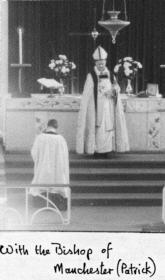
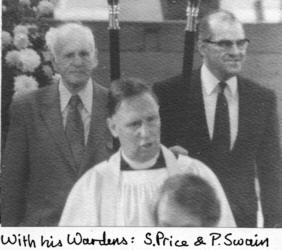
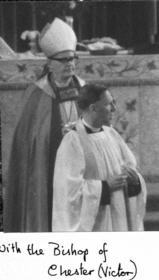
He urged the congregation to stand up for its faith, and contrasted two debates at General Synod- one on the ordination of women, which was full, and well reported in the national press, and one on evangelism and communication of the Gospel, which was two thirds empty and not mentioned in the press. The Bishop spoke without formality and his deep and resonant voice is well recalled.
During the Summer there was a break in the celebrations, and Mr Denton and his family returned for a holiday to their home town of Canterbury.
During a communion service at Canterbury Cathedral Mr Denton suffered a fatal heart attack.
A memorial service was held at St Thomas on 21st September and saw the church full to overflowing. I don't think the church has (at least in modern times) ever been so full. A fitting tribute to a man of God, who spent his entire period with us battling poor health.
The festival services continued, including a presentation in the church of The Vigil.
There was a lengthy inter-regnum during which the church-wardens, Mr Price and Mr Swain, worked to keep the parish functioning, ensuring a steady supply of ministers for the services.
The average number of communicants had fallen to 45 in 1970 and remained at that level for some time.

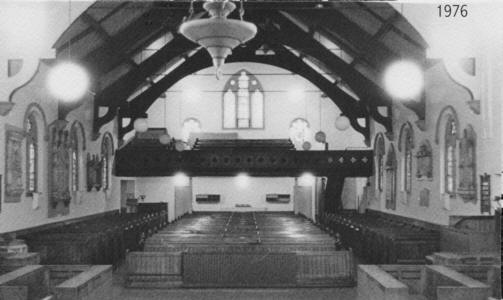
Plan of Church 1979 - use back button to return here.
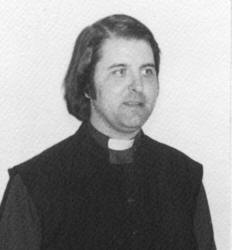
St Thomas was Mr Alderson's first appointment as Rector. Mr Alderson made a number of changes in the Parish, spread over a period. He had expressed to the first interviewing committee his Anglo-Catholic views, and had indicated that some changes would be made. Unfortunately the majority of those present understood this to mean something different to Mr Alderson, as unfortunately "some" can be understood to mean a lot, or a little. One member present had the same interpretation as Mr Alderson. There seems to have been no meeting of minds.
Amongst the changes made, in no particular order were:
Communion now referred to as Mass.
The Rectors Vestry now referred to as the Sacristry.
The use of the term Father in referring to any episcopally ordained minister.
Changes in worship included:
Conducting the principal part of the Mass from behind the altar, rather than from the front or side.
The introduction of Vestments rather than simple cassock and surplice.
The introduction of an Easter Vigil.
The benediction of the blessed sacrament.
A photograph of the church taken at the turn of the century shows a lectern in the centre of the church. The 1936 rebuilding gave the church a lectern at the side of the chancel. Mr Alderson reintroduced the practice of reading the Lessons from the centre, and also gave the sermons from this location.
To enable the Mass to be celebrated from behind the altar, the two altars had to be moved forward, and in the main body of the Church, the stainless steel altar cross was moved from the altar to stand behind the table, so once again, after the revolution of Mr Whatmough's altar cross, the altar had no cross upon it.
The dark dorsal curtain was removed to make the cross and minister more visible, whilst in the Lady Chapel the dorsal curtain and riddle posts were removed, and the fixed altar rail, which was becoming loose, was replaced by a free standing rail - although not in use this was already in the Lady Chapel.
The traditional Watch Night services on New Years Eve were abandoned.
Mattins disappeared and every morning service was now Mass, although the monthly evening Communion was abandoned. Mr Alderson said Mass every day of the week (except Saturday) at various times. The daily services led to the introduction of the Roman Catholic Missal, which provides a different reading and prayer for each day. The Mass used was the Church of England Series 3 service.
The Sunday Service times were amended, with Mass at 8am, 9.30am, and Evensong at 3pm. Attendance at Evensong fell from just over a dozen to four or less.
The old heating system was still a problem, and two oil fired industrial heaters were installed - as the fans of these were very noisy, they were run before the service then turned off during the service.
As may be appreciated, such changes did not please everyone, and the P C C treasurer ended his term of office on 31st December 1978, whilst the PCC Secretary (his wife) ended her term of office in April 1979, with both resigning from the PCC in March 1979. The Lay Reader although remaining in post, regularly worshipped elsewhere. The Rectors Warden, Mr P Swain, resigned in April 1979. All of these people were at the initial interview. Note that this time there was sadness, but none of the bitterness that seems to have grown when Mr Whatmough made his changes.
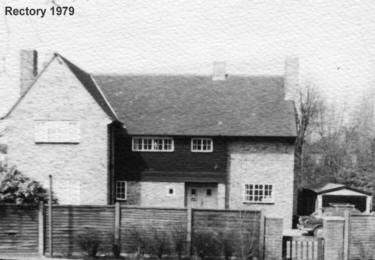
The level of the congregation remained more or less unchanged, for example the highest congregation in May 1974 was 60, whilst in May 1979 the comparable figure was 61.
The PCC purchased: a set of vestments (from a bequest left by Miss C Cooper), a sick communion set (in memory of Mr Denton, from the collection at his memorial service), and two ciboria (in memory of A Holt, the gift of his family).
The use of a sacring bell was introduced.
During Lent 1979 the 15 stations of the Cross were put on the walls, purchased with funds donated for the purpose in memory of J Boardman. The 15th station is The Resurrection. The style was modern. These were replaced just 15 years later. Memorial gifts in St Thomas do not have a history of respect or longevity, but fifteen years seems a record low.
The Girls Friendly Society donated a Madonna, and a sacring bell was given by Mr Clem Rutter.
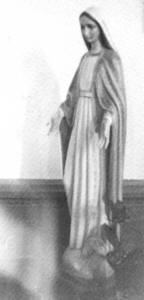
 About 1980/1981 the continuing unsatisfactory state of the church organ led to a degree of reconstruction work being carried out by the local Heaton Moor firm of Daly and Pickering Ltd (incorporated 19/1/78 and dissolved 20th January 1998) involving the retention of the existing pipework. The organ still had problems which were not resolved for another two decades.
About 1980/1981 the continuing unsatisfactory state of the church organ led to a degree of reconstruction work being carried out by the local Heaton Moor firm of Daly and Pickering Ltd (incorporated 19/1/78 and dissolved 20th January 1998) involving the retention of the existing pipework. The organ still had problems which were not resolved for another two decades.
In 1982, pianist Christopher Cotton was appointed as organist.
During the early 1980's there was considerable work on the church interior. The rather emergency and temporary industrial heaters were replaced with more conventional and quieter gas heaters, the pendant lights were replaced by powerful surface mounted lamps, and the old pews were removed. Once the floor had been levelled wooden chairs were introduced. All this work meant that services were held in the school hall for a couple of months.
Mr Alderson married shortly before he joined St Thomas, and his first born children, Kirsty Elizabeth and Helen Rachel were baptised on 12th November 1978.
After St Thomas Roger Alderson went to be vicar at Bedford Leigh.
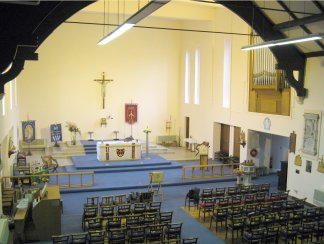
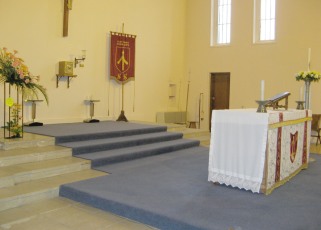
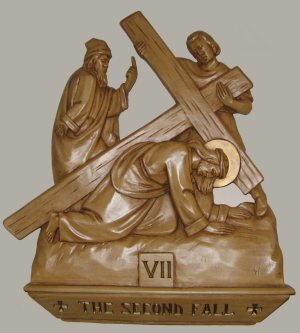
In 1997 the church Organ was inspected by the firm of A J Carter of Wakefield, who carried out extensive work on the wind pressure, noting the restricted finances meant that more work would be needed in due course. Their work produced a much improved tone.
Please note that I have been advised that the following story is not correct... Manchester Evening News - Tuesday, 20th January 2004
Teachers and parents at six primary schools have been told their schools will be axed. Nine schools had been on a Stockport council hit list for closure, but at a meeting last night councillors decided that three should be reprieved.
St Thomas' CE, Heaton Chapel; Brookside in High Lane; and Outwood, Heald Green were reprieved.
I have been advised that the St Thomas concerned was in fact the "other" St Thomas in Central Stockport, NOT our St Thomas in Heaton Chapel as stated. As the MEN story will be
archived long term, this correction will be retained to try to head off yet another historic inaccuracy caused by the number of St Thomas churches (and their schools) in the
vicinity.
From an undated "Team Ministry" web site found in 2005:
Quote: St. Thomas' distinctive tradition could best be described as Modern Catholic. The 2 main services in a week are the Parish Eucharist at 10 a.m. on Sundays and a weekday mass at 7.15 on Thursdays. Attendance on Sundays averages out at around 45 adults and 15 children. Thursdays see 6 - 7. There are additional services for different seasons and occasions such as Stations of the Cross during Lent. As regards occasional offices there may be 10 - 15 baptisms in a year, weddings only very occasionally (no more than one a year for the last few years). Unquote.
In 2005 the Church Notice Board indicated the morning service was at 9.30am.
In 2005 Carters carried out extensive work including complete releathering and overhaul of the motors, the result being that in 8 years of work the organ has been transformed from what had been unsatisfactory from 1934 into a pleasing and well sounding instrument. (Brief organ specification).
21st August 2005- a notice outside the chapel announces the first of a regular 2 hour Sunday service from 11am to 1pm, to be led by "Pastor Sam" of the Eternal Glory Christian Centre based in West Didsbury. This arrangement ceased in 2010.
In 2007 the school built a new small building to the North, tight up against the Church land, to serve as a reception, and joined to the old boys entrance by a glass corridor. Some attempt was made to match the style of the new tiny building to the brickwork of the old school. The Church erected a huge bright blue Notice Board announcing the two services of Eucharist and giving the current contact details of a minister (phone number and email address).
The congregation of Christ Church, Heaton Norris (the church steeple you see on the A6) joined with All Saints somewhat prior to the destructive fire that hit Christ Church in the late 1970's. Dwindling resources (financial and manpower) then required All Saints with Christ Church to share a minister more widely. The Heaton's team ministry of five churches sharing a team was introduced with one minister principly serving Christ Church (with All Saints) and St Thomas..
In addition to the grouping of the churches for the team ministry, it has been the practice for churches to gather together for major festivals (including cross denominational services) and in Christmas 2007 St Thomas celebrated the birth of its Saviour by seemingly keeping its doors locked all day as there was a joint morning daylight service at All Saints - the preceding joint midnight service on Christmas Eve was at St Thomas. (repeated in 2013).
The pressure on the limited number of paid ministers was released a little by the efforts of lay and non-stipendiary (unpaid) people. Mrs Glenys Heather Richards was Ordained Local Minister in the Heatons Team Ministry from 2006 and principly assisted at All Saints..
In 2008 the antiqued hammered effect metal cross on the exterior wall facing Wellington Road (see photo just below) was illuminated with a floodlamp and painted bright fluorescent green (repainted metallic silver in 2011). By November 2008 team minister Peter Stannard had left.
In 2010 moves were made to replace the separate wooden chairs which had replaced the old pews, with softer upholstered separate chairs. These were from part of a legacy left to the church by Jessie Carr.
A second blue notice board was erected outside the church in memory of Stanley Martin.
During the summer of 2013, a new non-stipendiary assistant curate, the Revd. Sheila O'Flaherty joined the team ministry and regularly assists at St Thomas's services.
Towards the end of 2013 considerable building work commenced at the school- the former small outbuildings on the road side of the school, used for a parish kitchen and for school storage, were removed and the wall rebuilt and windows inserted in the same style as the rest of the hall- an excellent restoration work. Restorative work was carried out on the small church bell tower.
The 1891 school building - the one built with buttresses to support a proposed second storey- at last in 2014 gained its second floor, when the former school hall was given a flat ceiling, the roof was rebuilt and windows inserted into the roof.
In 2015 the very large trees alongside Buckingham Road were removed, possibly dealing with the movements to the most recently built part of the building, the narthex. The school playground behind the church had been laid over the old graveyard in 1959 - the bodies were not disturbed, and tarmac laid over. In 2015 many deep holes were made in this area for new fencing posts for an enclosed and heavily fenced play area (within the already heavily fortified playground!). These will have gone through any remains underneath. However no regard is paid to buried remains in these modern times - extensions to Manchester Metrolink have disturbed a number of burials in several central Manchester locations.
It has been reported that the "official" name of the Parish was changed by the diocese to "Heaton Chapel" in 2015.
A blue plaque was affixed to the church school wall in 2018 to celebrate a brief period at the school by John Alcock, just before his family moved from Old Trafford to Lytham - he may have been staying with his grandparents on Manchester Road, He later became the first person to fly the Atlantic none stop (Canada-Ireland).
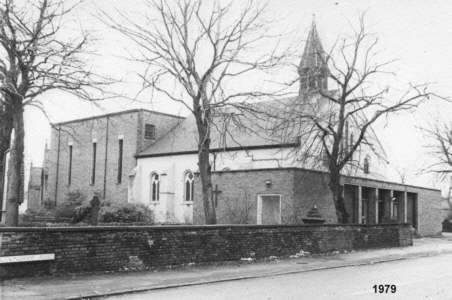

The church is not left open during the day.
From outside the church looks unusual, and has no pretension to beauty. The central part, the Nave, is the oldest, mostly dating to around 1758, although the moulding over the windows, the mullions, and the glass are 1870. The buttresses are also 1870 apart from that nearest to the Chancel, which is 1936.
The moulding over the Chancel end window looks damaged, but that is not the case. In an earlier time a transept came out very close to this window and the missing part was never there because there was a wall in the way.
The Chancel End is 1936, designed by B A Miller.
The entrance to the church was for a time on Buckingham Road, but the original entrance has now been returned to use- this is reached via the Lych Gate (1890), passing the First World War memorial. This original entrance facing Wellington Road North is a 1960 rebuild, with a Wardens Vestry to its left. The door leads into a Narthex from which two doors lead in to the Nave.
The wall at the back of the church is probably 1758, but the Lady Chapel dates from 1960 and now contains the first altar (circa 1928) which replaced the earlier communion table.
The original wooden floor over concrete (now covered) and roof are probably 1870.
The round headed windows at the sides are mostly 1758 but the windows nearest the chancel may be 1838.
The window mullions, labels and glass are all 1870 as is the gallery at the back, although there was originally a previous gallery, probably flat rather than stepped. The Arms in the larger window at the back of the church are on the left the Hulme family and on the right the Egerton (of Tatton) family.
Most of the light oak furnishing is by Shepherdsons of Stockport, and the light over the altar was in memory of a previous incumbents wife, Mrs Whatmough (these were all removed around the early 1990s)).
The St Christopher was surplus to the requirements of a church of that name.
The somewhat square shape of the Chancel is due to a potential plan to build a new nave aligned with Buckingham Road.
The Wall Tablet memorials are:
1843...William Travis (warden)
1846...A Green
1851...T Rostron
1858...J E Turner (Warden)
1862...T M Fisher
1864...H Taylor (East Window- now lost)
1879...E D Jackson (incumbent)
1882...J D Bird (warden)
The 1890 Lych Gate is in memory of T Beaumont (Warden)
There was a mosaic pavement (1904) in memory of J Henn (incumbent) but this has been destroyed.
Other memorial gifts include:
1925- Bible (S S Sutcliffe-incumbent); 1934 Prayer Book (K I Carter);
circa 1940- Sanctuary lamp hanging from ceiling in memory of Mrs Whatmough (removed c.1992);
1942 Processional Cross (W Chapman); 1944 Flagon (R K Ridgway);
1945 Prayer Book (G Crimes); 1947 Wafer Box (A Caldwell); 1949 Litany Stall (A MacGill); 1950 Bookstand (P Atkinson);
1951 Organ Console (H Greenwood); 1957 Font Cover ( M R Gutteridge); 1959 Sanctuary Chair (D F Burdett); 1962 Lectern and Bible (C J Knight); Gilt cross and candlesticks ( G M Briscoe); Altar Table (J Bowker); 1967 Bible (G J Bowers); 1970 Flower Stands(2) (K Smith); 1971 Cross and Candlesticks (A Taylor); Green frontal (F Picker); about 1972 Bible (H and L Smith); Book Shelves (E Vizard); 1973 Prayer Book (Mrs M G Cooke); 1977 Two industrial heaters (S Price, S Lawson, Mrs Mars, K Walker, Mr Lorange, Miss C Cooper); Flower Stand (S Lawson); 1978 Vestments (4) (C Cooper); Sick communion set (P F B Denton); 1979 Stations of the Cross (J Boardman)(replaced around 1993); 1991 Communion rail(Albert and Evelyn Mary Finch); 1992 Memorial Plaque on the organ console (Marie Baker); circa 1992 Wall mounted lamp (Pauline Ann Hayes); circa 1993 Stations of the Cross replaced (May Paine)
1832 First organ (Renn)
1838 Parish status
1847 First rectory
1848 Transfer to new Diocese of Manchester
1854 Gas lighting installed
1865 Font, Church Plate
1866 First church school built
1870-74 Extensive rebuilding
1892 New school building
1897 Second Organ (Jardine)
1910 Electric lighting
1920 PCC formed
1928-33 Liturgical changes
1936 New East end
1940 (about) Sanctuary Lamp hanging from ceiling.
1951 Third organ (Walklett)
1957 New rectory built
1959 Churchyard closed
1969 New West End
1964 Old rectory demolished
1968 School extended
1976 Liturgical changes
1991 New communion rail closer to the Nave.
The officers of the Church 1765-1979 || Signatures of some incumbents
Church History: Page One || Page Two (1844-1879) || Page Three (1880-1926) || Page Four (1926-1965)
Access Key Details
Stephen's Entry Page |
TI99/4a |
Linux |
Search |
History St Thomas Church Heaton Chapel |
Entertainment
Music Links ||
Light Reference |
Educational Reference |
Science Fiction |
Travel |
News Links |
Anime